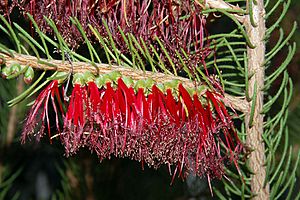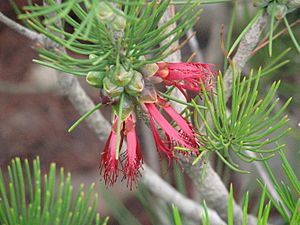Calothamnus facts for kids
Quick facts for kids Calothamnus |
|
|---|---|
 |
|
| Calothamnus quadrifidus | |
| Scientific classification |
|
| Kingdom: | Plantae |
| Clade: | Tracheophytes |
| Clade: | Angiosperms |
| Clade: | Eudicots |
| Clade: | Rosids |
| Order: | Myrtales |
| Family: | Myrtaceae |
| Tribe: | Melaleuceae |
| Genus: | Calothamnus Labill. |
| Synonyms | |
|
|
Calothamnus is a group of shrubs that belong to the Myrtaceae plant family. These plants are special because they only grow naturally in the south-west part of Western Australia. This means they are endemic there, found nowhere else in the world!
Some Calothamnus species are known as one-sided bottlebrush or claw flower. This is because their flowers often grow on just one side of the stem. Also, their flowers can look a bit like claws. These plants are usually medium to tall shrubs with many leaves packed closely together. The flowers are often bright red.
Contents
What do Calothamnus Plants Look Like?
Calothamnus plants are usually medium to tall shrubs. Some types even grow low to the ground. Their leaves are long and narrow. They often have tiny oil glands you can see.
The flowers grow in small groups or dense spikes. They can be on older, bare stems or among the leaves on younger stems. Each flower has small petals that fall off quickly. But the most interesting part is the many stamens. These are the parts that hold the pollen.
The stamens are long and usually bright red. They are joined together for most of their length. This forms four or five "claws." In some species, the top two claws are even joined together. The stamens can be crimson, deep purple, or sometimes yellow. After the flowers bloom, they produce a hard, woody fruit called a capsule.
Naming Calothamnus Plants
The first Calothamnus plant described was Calothamnus sanguineus. This happened in 1806. A French scientist named Jacques Labillardière officially described it.
The name Calothamnus comes from two Greek words. Kalos means "beautiful," and thamnos means "a shrub" or "a bush." So, the name means "beautiful shrub."
Scientists sometimes change how plants are grouped. In 2014, some scientists suggested that Calothamnus plants should be moved. They thought these plants, and others, should become part of the Melaleuca group. This idea came from looking at their DNA.
Where Calothamnus Plants Grow
All Calothamnus species live in the south west botanical province of Western Australia. They grow in different places. Some, like Calothamnus aridus, like dry areas. Others, like Calothamnus hirsutus, are often found near swamps. This shows they can adapt to many environments.
Growing Calothamnus in Gardens
Many types of Calothamnus plants can be grown in gardens. They need lots of sun and soil that drains water well. This means the soil should not stay too wet.
You can usually grow new plants from their seeds. The seeds stay inside the hard fruits on the plant for a long time. You can also use cuttings from the plant. This is especially good if you want to keep the special yellow color of some types.
Images for kids
See also
 In Spanish: Calothamnus para niños
In Spanish: Calothamnus para niños



